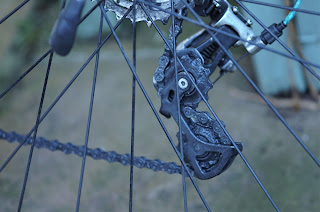The Pure Dry Lube is showing the characteristics of a traditional, petrochemical formula- the sort made from refined paraffin wax and solvent. It’s turned molten and some has migrated to the chain’s side plates, though not the cassette, which surprises me.
Still plenty on the rollers, 225 miles in and I was expecting to purge a gungy looking beard that had accumulated along the side plates, jockey wheels etc. I was pleasantly surprised to discover it has scabbed off, during subsequent rides.
Wax formulas, without a PTFE, or similar additives mean chains tend to succumb to light, filmy corrosion, following wet rides. Another reason why I don’t go this route with cleat hardware and others prone to getting blasted with dodgy water. True to type, the Pure has done just that. Not an issue with the more sophisticated dry blends.
While they will generally run cleanly, waxes require a more disciplined approach to drivetrain cleanliness, first time round, hence the argument these have more benefit to racers-time triallists and mountain bikers (during the summer months), rather than commuters.
One I concur with in some respects. Arguably, working bikes should be ready n’ reliable, with minimal faff. Wet lubes are an obvious choice and will certainly go the distance, but as I’ve said many times before, the side plates will need wiping regularly. Otherwise, accumulated grit/grime turning into a grinding paste, chomping through your bike’s drivetrain.
If you’re pressed for time, one of the pour n’ go sort, such as Finish Line 1-Step Cleaner and Lubricant https://www.sevendaycyclist.com/finish-lineMight be an easier proposition, even if these require more frequent reapplication. Once the existing Pure dry lube is spent (coinciding with the chain, I suspect) I may well revert to the low-friction Zefal Pro-Dry Lube.https://www.sevendaycyclist.com/zefal-pro-dry-lube This incidentally appears fully compatible with the Pro Gold Prop Link Chain Lube https://www.sevendaycyclist.com/pro-gold-pro-link-chain-lube if my fixed gear winter trainer’s chain is anything to go by, several weeks down the line.
Talking of wax, I’ve treated the Univega to another high-quality waxing. Muc-Off Miricle Shine polish, this time around. It’s made using Fluro Polymer Technology and Carnauba wax. The latter is also found in high-quality furniture polish, cosmetics, and even speed boat hulls. Silicone oils are apparently employed to enhance ease of application and, it’s very quick and easy to apply.
One coat is sufficient but if like me, you like to double up at key areas (bottom bracket shells, down tube, chainstays etc), experience suggests it prefers 24hours between coats. Rounding up this polishing theme is a guide to caring for traditional leather saddles https://www.sevendaycyclist.com/caring-for-leather-saddles . My derriere has very much bonded with the Cycles Berthoud Soulor Saddle https://www.sevendaycyclist.com/cycles-berthoud-soulor-leather-sadd
Several weeks further down the line, the Kenda Kwick Roller continue to impress with their blend of low rolling resistance, reassuring grip and of course, puncture resistance. A greasy, wet winter may reveal some limitations (specifically the puncture repelling belt, which covers the centre strip, rather than edge to edge).
That aside; they’re doing everything I ask of them and the slightly narrower (32mm) section is probably optimal, for my fixed gear winter/trainer’s clearances too. Elsewhere, those looking for a responsive and engaging folding bike may want to take a closer look at this Tern BYB S11 Folding Bike https://www.sevendaycyclist.com/tern-byb-s11-folding-bicycle














